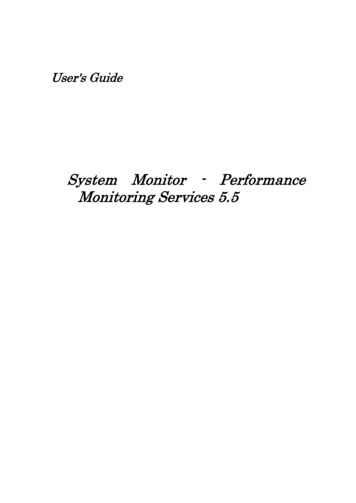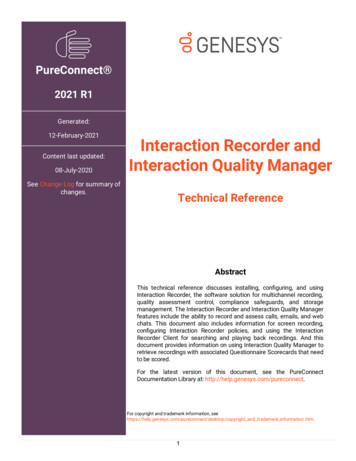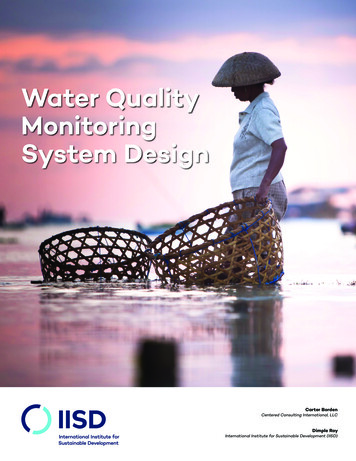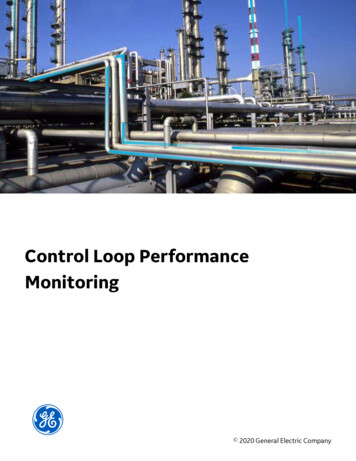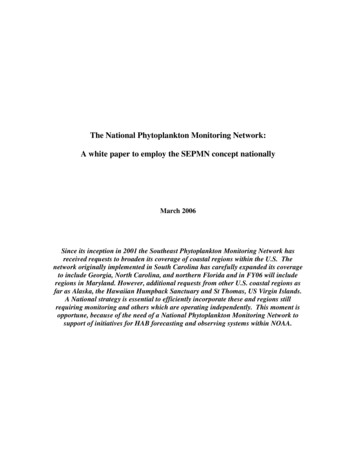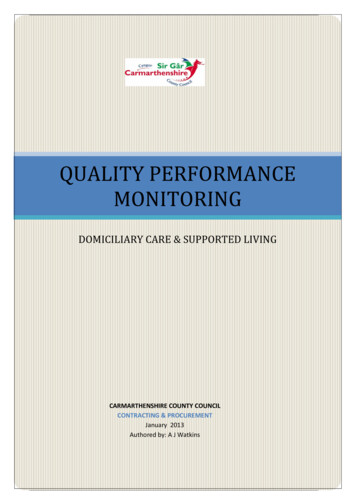
Transcription
QUALITY PERFORMANCEMONITORINGDOMICILIARY CARE & SUPPORTED LIVINGCARMARTHENSHIRE COUNTY COUNCILCONTRACTING & PROCUREMENTJanuary 2013Authored by: A J Watkins
QUALITY PERFORMANCE MONITORING PROTOCOLDOMICILIARY CARE & SUPPORTED LIVINGINTRODUCTIONCarmarthenshire County Council has a duty to respond to concerns about standards of care within allits contracted services. Previously, concerns about the quality of care provided to service users whowere in receipt of a Domiciliary Care service were responded to by the CarmarthenshireCommissioning and Contracting team, often working closely with the Care and Social ServicesInspectorate, Wales. Whilst information was sought and shared with partner agencies, it was felt thatthe response could be more proactive and at an earlier point.This protocol sets out how the Commissioning and Contracting team will monitor service provisionand respond to initial, on-going and/or serious concerns regarding standards of care. It sets out howinformation is communicated effectively, how a response is coordinated within a timely manner andhow agreed actions are monitored.Carmarthenshire County Council’s Domiciliary Care Contract Terms and Conditions are a reflection ofthe requirement within the national minimum standards for domiciliary care. Each Provider will besubject to continuous quality and performance monitoring in accordance with the Council’s ProviderPerformance monitoring Protocol. This is central to the continuous improvement of services deliveredto Service Users. The Council will conduct quarterly quality and performance contract reviewmeetings and conduct a risk assessment of each Provider’s performance.This protocol ensures practice in Carmarthenshire is compliant with the Standard Terms andConditions within the Domiciliary Care contract and specification. It should be noted that this protocolis used for all commissioned services (In house and external) and all service user groups.Each agency has a clear role to ensure that satisfactory care is delivered to vulnerable adults and,where care is inadequate, to communicate concerns both internally and where appropriate externally.This ensures that actions of advice, support and monitoring can be considered and selected to assistservice improvement.The Commissioning and Contracting team use a range of methods to engage with providers toreinforce their expectations of quality service being provided to service users in Carmarthenshire.Methods used include: visits; meetings; reports, correspondence and action plans.VALUESCCC are committed to ensuring that the values and rights below underpin the way in which theirservice users should be supported and cared for in whatever settings or places they live in or use:Independence: to think, act and make decisions, even when this involves a level of risk.Dignity: recognition that everyone is unique, with intrinsic value as a person.Respect: for a person’s needs wishes, preferences, language, race, religion and culture.Equality: the right of people to be treated no less favourably than others because of their age,gender, disability, sexual orientation, religion, class, culture, language, race, ethnic origin or otherrelevant distinctions.
Privacy: the right of the individual to be left alone or undisturbed and free from intrusion or publicattention in their affairs.Choice: the right to make choices, and to have the alternatives and information that enable choicesto be made.KEY PERFORMANCE INDICATORS6 key performance indicators (KPI’s) have been devised in order to monitor the quality of serviceprovision for providers. Each of the 6 KPI’s are linked to key quality outcomes identified within thequality monitoring section.6 Key Performance Indicators: Timeliness and Reliability of ServicesCommitted WorkforceService User Safety (Safeguarding)Service User Empowerment (Complaints)Meeting Assessed NeedsCCC contract complianceProviders will be required to provide an update on performance on a quarterly basis, in a formatprovided by CCC. (Please see Appendix 5). Dates will be agreed in accordance with Contract ReviewMeetings.KEY QUALITY STANDARD1. Timeliness and Reliability of services - Service users and carers should expect their domiciliarycare provider to arrive in a timely fashion as identified within their care plan and as agreed with theprovider. This KPI will identify and monitor missed calls and late calls.Outcomes Improved Health and Wellbeing, Improved Quality of Life, Maintaining Independence,Personal Dignity and Respect.2. Committed Workforce - A happy and steady workforce will impact positively on the consistency ofthe carers and therefore quality of care provided. Monitoring staff retention within the company willevidence if domiciliary care providers are working to improve this. Monitoring staff sickness within thecompany will evidence if domiciliary care providers are providing continuity and are working to reducelevels of staff sickness.Outcomes - Improved Quality of Life, Maintaining personal dignity and respect3. Service User Safety –Ensure that the provider complies with the All Wales procedure for thesafeguarding of vulnerable adults. The domiciliary care national minimum standard (21) states thatStaff supervisions should occur every 3 months. CCC believes that regular supervisions work towardsstrong safety measures for service users and also improve the quality of services provided. Thedomiciliary care national minimum standard (20) states that at least 50% of front line staff shouldhave a Level 2 NVQ in Health and Social Care. CCC believes that a well trained workforce will worktowards strong safety measures for service users and also improve the quality of services provided.Outcomes - Improved Health and Wellbeing, Improved Quality of Life, Freedom from Discriminationand Harassment, Maintaining Personal Dignity and Respect4. Service User Empowerment. Ensure the provider demonstrates Human Rights and EqualOpportunities by actively undertaking Service User Reviews / Quality Assurance. Monitoring theprovider’s performance in completing service user reviews will ensure that providers are working to
improve in the area of Service User Empowerment. Monitoring the provider’s performance in dealingwith complaints in a timely manner will evidence that a provider ensures that service users viewpointsare taken seriously.Outcomes - Freedom from Discrimination and Harassment, Maintaining Personal Dignity andRespect, Making a Positive Contribution, Increased Choice and Control5. Meeting Assessed Needs. Ensure that the provider delivers services which achieve the maximumrehabilitative effect and which support, sustain and where appropriate enhance the service usersindependence. This will require the agency to provide a detailed service delivery plan for each serviceuser - which complements the UAP care plan assessment. Agencies will also need to consider ongoing changes to service provision in the form of developing service outcomes, staff skills and newways of working across the sector.Outcome – Promoting and maintaining independence and enhancing the quality of life of eachservice user6. Contract compliance. CCC rate domiciliary care services based on how they perform against thenational minimum care standards. This is therefore a quality measurement. Working to the Contractspecification and following the Authorities mandatory policies will ensure that the provider is workingin line with the expectation of the Authority.Outcome – High standard / Quality service. Sustainability.AUDITINGCCC may conduct audits on any KPI submissions they receive in order to ensure that providers aresubmitting their information and are following the KPI guidance correctly.Identified concerns will be recorded on the Council’s Events Log and measured against the KeyPerformance Indicators (KPIs) as set out in this document. The risk assessment may result in achange to the Provider’s quality rating (in line with the provider performance monitoring protocol). Ifso, the Council may issue the Provider with an Action Plan to improve their quality rating.CONCERNS RAISEDCCC is committed to partnership working with all provider agencies. This protocol aims to provideearly intervention guidance to agencies with an outcome that the agency will have an opportunity torespond and take appropriate action regarding the concerns raised.Any concern reported in to the contracting team will be risk assessed in the first instance. This is toensure that any issues which may give cause to alert the Safeguarding team are reportedimmediately. (All safeguarding concerns will follow the safeguarding process) The contracting officerwill also establish whether the complainant wishes to make a formal complaint via the complaintsprocess. (All formal complaints will follow the complaints process). If the concern has no requirementto follow either of the processes as described, the contracting officer will then forward the concern onto the registered manager of the agency to request a response to the concern raised and to confirmwhat actions have been taken to manage the concern. This will enable the provider to give theiraccount and work in collaboration. (Please see Appendix 1A)RESPONSE TO CONCERNSCCC will expect the agency manager to investigate the concern as a matter of importance. Theagency manager must ensure to provide a clear response that includes the reason why, what actionshave been taken to resolve and what preventative measures have been introduced. The contractingofficer will risk assess the response and consult with the case manager to agree that the concern canbe closed as satisfied. However, should the response not provide the required information, the
contracting officer will inform the agency manager and request that specific areas be looked furtherinto.MULTIPLE CONCERNSWhere there are a number of concerns reported, either together or intermittently, the contractingofficer will commence recording the concerns on the events log. The events log will be shared withthe agency manager with the expectation that agency manager will provide a response to theconcerns in the response column. The contracting officer will risk evaluate the events log and makean informed decision with regard to the risk rating of the agency.THE EVENTS LOGThe events log is a Quality and Performance Monitoring tool which enables sharing of informationabout adult social care service provision. Information is obtained on complaints, safeguarding andabout minor service provision concerns that were not significant enough on their own to warrantformal escalation within the complaints or safeguarding environments and which otherwise might belost.The events log will be used as a tool for continuous monitoring, because it will able to identifypatterns. This will assist in CCC being confident that providers are still providing a service thatcomplies with the contract. Information gathered will be used in the risk assessment. If there areconcerns highlighted as a result of the analysis of the events log and if it is appropriate, details will begiven to the agency manager in order to provide a response. (Please see Appendix 4)RISK ASSESSMENTCCC will conduct regular risk Assessments on the provider. The risk assessment will involve lookingat the performance of the KPI’s, events log and action plans.What determines a risk? A drop in performance on KPI’s or failure to improve over a number of months.Evidence of poor quality service provision extracted from the Events logProviders failing to meet deadlines agreed in action plans.If a provider is determined to be of high risk by CCC Provider performance group, this could initiate anumber of scenarios: Review of the overall PP rating – A decision may be made to escalate the provider throughthe traffic light system (Please see Appendix 1) No further placing of packages – interim / indefiniteAGENCY PROVIDER PERFORMANCE MEETINGIn the event of an agency being within the provider performance risk category, the contracting officerwill arrange a provider performance meeting to discuss the events log. The meeting will explore theconcerns identified with the provider who must be given the opportunity to give their account. Thechair of the provider performance meeting will consider whether the agency is taking reasonableaction to address the current concerns and whether they are being proactive in preventing reoccurrences. Meetings held under this protocol will focus on the care provider and are separate toPOVA meetings which are held about individual service users who are alleged victims of abuse orneglect.Attendees at the Provider Performance meeting may include relevant internal representatives fromthe Commissioning and Contracting Team, the Safeguarding Team and the Assessment/ CareManagement Team. Other key stakeholders might include Care and Social Services Inspectorate
Wales and in some instances, Hywel Dda Health Board representatives may attend. The contractingofficer will provide an agenda for the meeting and will arrange for the minutes of the meeting to becirculated to all in attendance.The Provider Performance Meeting replaces both contract review meetings and overarchingmeetings; bringing one system for early identification of concerns, sharing of information andmultiagency action planning.PROVIDER’S ACTION PLANCCC will issue providers with an action plan if the quality of service provision is rated as high risk ofescalating concerns. This may have been populated with information provided from a variety ofsources: the quality assurance meeting; POVA investigation findings; complaint outcomes; concernsfrom reviews of service user care or CSSIW and contract monitoring episodes. The provider’sprogress on actions ‘identified within action plan’ will be used in the risk assessment. (Please seeAppendix 3)The chair of the provider performance meeting has a key role in appropriately but robustly challengingthe agency where they are not committed to the improvements required – for example consistentfailure to attend meetings and enter into discussion about concerns and risks, not making progress orslow progress on the improvements required, not fully engaging in the process. A letter will be sent bythe chair of the meeting setting out the concerns re lack of engagement and expectations forimprovement. The provider will be reminded of the contract with the local authority and the need towork in partnership for the benefit of the service users we support.Where the required improvements have been made by the care provider and the providerperformance meeting participants are in agreement, a decision will be made to close the process if allconcerns have been addressed and actions are evidenced, this could also result in the agencyreverting back to their usual contract review meetings. In some circumstances, it may be recognisedthat the agency is making improvements but may require further support or guidance, the decisioncould therefore be to close individual concerns that have been addressed which will then reduce therisk rating. The agency will be informed of any decision made.SUSPENSION OF PLACEMENTSInterim arrangement - If an agency has not responded to the initial concerns raised, a risk evaluationwill be undertaken to establish whether new packages are to be placed with the provider – pendingthe outcome of the agencies response. This decision will be communicated to the agency manager inwriting.Indefinite - In the event that the agencies’ performance is not improving and they are not followingadvice from the provider performance partners, a decision will be made by the Director ofCarmarthenshire County Council as to whether or not it is appropriate to suspend any new businesswith the organisation, whilst maintaining existing contracts until the issue has been resolved orwhether or not the contract must be terminated and services be delivered by an alternative provider. Ifthe decision is taken to suspend new placements/packages of care then CSSIW along with the otheragency partners will be informed and a letter is sent to the Provider setting out the rationale.
APPENDIX 1KEY PERFORMANCE INDICATORS – GUIDANCE1. Timeliness and Reliability of ServicesDefinitions: Visit – a domiciliary care call, which has taken place. For visits in which more than one carerattends, this should be counted as 1 visit only and not 2.Late Call – is when the carer arrives more than 30 minutes after the agreed timeEarly Call – is when the carer arrives more than 30 minutes before the agreed timeMissed Call – is when a carer doesn’t arrive for the visit at all.Visit times are banded as follows:AM – Call must be delivered before 11:30amLunch – Call must be delivered between 11:45am – 2:45pmTea – Call must be delivered between 3:00pm – 5:30pmEvening – Call must be delivered between 5:45pm – 7:00pmNight - Call must be delivered between 7:15pm – 11:00pmStated time on the Service Delivery Plan – This can be an agreed time or a time slot.CCC expects the provider to take into consideration travelling time for care visits before agreeing timeslots.How to measure timeliness of visits when time slots are stated on a Service Delivery Plan:Example - if a service user has a morning call identified as being between 8 and 8:30am. The call would be early if the carer arrived at or before 7:30am The call would be late if the carer arrived at or after 9:00am The call would be missed if the carer arrived at or after 11:30amMeasuring late, early and missed calls - what should be taken into consideration: When a client has been informed prior to the visit.When the issue is down to emergency staff absence or emergency with previous visitGenuine travel delayMeasuring late, early and missed calls – what requires action by the provider: Staff lateness, mistakes in rota planning, staff not following rota correctly and any otherreason that is not attributable to the service users request.CCC will regard these as a concern.Measuring late, early and missed calls what shouldn’t be included When a client is not in.When a client has informed the provider that the call is no longer required or is needed at adifferent time that will not be a permanent change.
Collecting the dataCCC will require information on the total number of visits carried out in a sample week for eachquarter. The estimated or total number of visits that took place during the reporting period should becounted.For example if the reporting period was one week and 7 clients receive 21 visits in that week, the totalnumber of visits counted in the KPI submission template would be 147 (21X7 147).It is expected that for those agencies that have an electronic monitoring system that the informationrequired will be obtained upon request. For those who do not use an electronic monitoring system ortheir system is not capable of providing the required information, data can be provided from the dailyrecord book. Further guidance on sampling is found in the next section.Collecting a sampleThe objective of collecting this information is to drive improvement in service.The sample size will be 5% of the total number of service users the agency delivers care to. Service users will be selected at random. The size of the sample will need to be statistically credible. The sampling period needs to be representativeKey requirements when collecting a sampleService delivery sheets can be used as evidence but visits shouldn’t be counted for those that havenot been signed by the client due to lack of capacity or unable to sign. For any other unsigned visitsthese will be counted as missed calls.Providers must state on the KPI submission template if there were any issues or any incidents thattook place in the sample week and provide details on how that week was affected - in the free textfields.2. Committed WorkforceA. Staff Retention - No of permanent staff leaving the company during the reporting period.Definition: Permanent Staff– Staff who have a contract with the company, which has no terminationdate.Temporary Staff – Agency staff or staff who have a contract with a termination date.Number of posts (vacant/ filled) - the number of post determined within the company’sstructure.Staff Retention A happy and steady workforce will impact positively on the consistency of the carersand therefore quality of care provided. Monitoring staff retention within the company will evidence ifdomiciliary care providers are working to improve this.Worked Example Suppose the number of permanent staff that left the company was 5 and theaverage number of posts (vacant or filled) in the company was 75 . The percentage of staff leavingpost in the reporting period (5 75) X 100 6.67%Good PerformanceGood performance is typified by a lower percentage
What this indicator does: Measures staff retention, by capturing the number of permanent staff thathave left the company during the reporting period, compared with the number of staff in thecompanies structure.B. Staff Sickness - Average number of sick days per member of staffDefinitions: Per member of staff - All staff employed by the company, including temporary and agencystaff.Average Number of filled posts - the average number of filled posts over the reportingperiod, this can be with permanent or temporary staff.Sick Days – Days lost because members of staff cannot attend work due to illness.Staff Sickness: Monitoring staff sickness within the company will evidence if domiciliary careproviders are working to reduce levels of staff sickness.Worked Example Suppose the total number of sick days taken in the company during the reportingperiod was 29. Suppose the number of filled posts in the company during the period was 75. TheAverage number of sick days per member of staff 29 75 0.39 daysGood PerformanceGood performance is typified by a lower figure.What this indicator does: Measures staff sickness, by capturing the average number of sick daysper member of staff during the reporting period. Staff on long term sick leaveWill be countedCollecting Data – CCC will require this information quaterly at the contract review meeting. Howeverit is advised that providers inform the contracting team of any difficulties that may affect servicedelivery.3. Service User SafetyA. Staff Supervision - % of staff that have had formal supervision with their line manager within the 3months prior to reporting.Definitions: Formal Supervision – should occur every 3 months at pre-arranged times in a quietenvironment free from the distractions of service delivery. Supervision sessions should lastabout one hour and form an essential feature of the placement and supervisory processNumber of staff eligible for 3 monthly supervision- the number permanent and temporary(including agency) staff within the company who will be due a supervision within the reportingperiod.Staff Supervision – CCC believes that regular supervisions work towards strong safety measures forour service users and also improve the quality of services provided.Worked Example Suppose the number of staff who have had a 3 monthly supervision was 15 andthe number of staff eligible for supervision in the company was 27. The percentage of staff who havehad supervision (15 27) X 100 55.56%Good PerformanceGood performance is typified by a higher percentage.
What this indicator does: Measures the level of staff supervisions, by capturing the percentage ofcompleted supervisions within the reporting period for all staff members within the company.What to exclude: Staff that have been in post for less than 3 months.B. Staff Training - % of staff that have achieved a NVQ / QCF level 2 qualification in Health andSocial Care.Definitions: NVQ / QCF – is a 'competence-based' qualification: this means staff learn practical, workrelated tasks designed to help staff develop the skills and knowledge to do a job effectively.Number of Staff – Is the total number of staff employed by the company during the reportingperiod. For example if at the beginning of the period the company employed 30 staff and atthe end of the reporting period the company employed 35 staff but 10 members of staff left thecompany, the total number of staff would be 45.Staff Training - CCC believes that a well-trained workforce will work towards strong safety measuresfor our service users and also improve the quality of services provided.Worked Example Suppose the number of staff that have a NVQ level 2 qualification in Health andSocial Care is 25. Number of staff within the company is 35. The percentage of staff who haveachieved a level 2 qualification in Health and Social Care 25 35 X 100 71.43%Good PerformanceGood performance is typified by a higher percentageWhat this indicator does: Measures the level of staff who have achieved a level 2 qualification inHealth and Social Care. It also evidences staff skills and competeny.What to Include: Front line staff and Managers who line manage front line staff.What to Exclude: Staff within the company who do not provide domiciliary care services directlyand/or do not line manages staff that do.C. Safeguarding Procedures - Number of Safeguarding referrals that have been made indicating poorpractice.Definitions: Safeguarding Referral – is an allegation of abuse which may have occurred as a result ofpoor service provision that has resulted in significant harm to the service user.Abuse is defined as:a violation of an individual’s human and civil rights by another person orpersons which results in significant harm. Abuse may be: a single or repeated act, or multipleacts; a lack of appropriate action; perpetrated as a result of deliberate intent, negligence orignorance; and/or an act of omission (failing to act) or neglect.Significant harm’ refers to: ill-treatment (including sexual abuse and forms of ill-treatmentthat are not physical); impairment of, or an avoidable deterioration in, physical or mentalhealth; and/or impairment of physical, emotional, social or behavioural development.Safeguarding – CCC believe that all staff have a duty to report any concerns that they have aboutthe safety and wellbeing of a vulnerable adult.Good PerformanceGood performance is typified by Managers being proactive in ensuring that information is beingreported and appropriate action is being taken to eliminate any risks.
What this indicator does: Identifies Measures the actions taken by all staff regarding reportinginformation.5. Service User Empowerment.A. Service User Reviews - % service users that have received a review of their services within thereporting period.Definitions: Service User Reviews – is an examination of the service users needs and must include aformal reassessment. It is an exercise that obtains the service user’s view.Service User Reviews – CCC believes that monitoring the provider’s performance in completingservice user reviews will ensure that providers are working to improve in this area.Worked Example Suppose the number of service users that have had a review of their serviceswithin the reporting period 127. Suppose the number of service users in receipt of services during thereporting period is 175. The percentage of service users that have received a review of their serviceswithin the reporting period is 127 175 x 100 72.57%Good PerformanceGood performance is typified by a higher percentageWhat this indicator does: Measures the % of service users in receipt of services from the providerthat has had a review within the reporting period.What to include: All service users who the provider is providing domiciliary care services to onbehalf of CCC, during the reporting period.B. Service User Complaints - % of complaints that have been completed within the time scale statedin CCC complaints policy.Definitions: Complaint – is an expression of displeasure or dissatisfaction, such as poor service provision.Complaints – CCC believes that monitoring the provider’s performance in dealing with complaints ina timely manner will evidence that a provider ensures that service users viewpoints are takenseriously.Worked Example Suppose the number of complaints that were resolved/completed within thetimescale set in the complaints policy during the reporting period was 4. Suppose the total number ofcomplaints that were resolved /completed in the reporting period was 8. The percentage ofcomplaints that were dealt with on time within the period (4 8) x 100 50%Good PerformanceGood performance is typified by a higher rating.What this indicator does: Measures the timeliness of dealing with complaints and ensuring toaddress the concerns raised.
APPENDIX 1AMAPPING PROCESS - CONCERNSCONCERN REPORTED TO CONTRACTINGDISCUSS WHETHERNEED TO REFER TOCOMPLAINTS DPTCONCERN/S TO BEPROCESSED VIACONTRACTINGDISCUSS WHETHER NEEDTO REFER TOSAFEGUARDINGAGENCY TOINVESTIGATE IN LINEWITH STAGE 1DISCUSS CONCERN WITHAGENCY & FORWARD VIAE-MAILOUTCOME OF SOVA TOBE REFERRED TOCONTRACTINGAGENCY REQUIRED TOPROVIDE RESPONSE &ACTIONS TAKEN TOPREVENT RE-OCCURENCEAGENCY RESPONSERECEIVED &SATISFACTORYNOYES
CO TO ARRANGEPROVIDERPERFORMANCEMEETING WITHAGENCYCMO TO UNDERTAKESAMPLE MONITORING OFAGENCYCMO TO UNDERTAKEMONITORING VISITS TORISK ASSESS AGENCYPERFORMANCENOHAVE CONCERNS BEENADDRESSED UNDERPROVIDERPERFORMANCECO TO ARRANGE 2NDPROVIDERPERFORMANCE MEETINGWITH AGENCYCONSIDER SUSPENSIONOF PLACEMENTINFORMCOMMISSIONINGNETWORKYES
APPENDIX 2RISK ASSESSMENTRisks will be assessed and reviewed during the provider performance Meeting.For all cases a risk rating system will apply in line with a rating of red, amber, yellow andgreen based on key evidential factorsWhere there are cases of complexity and significance, a risk tool matrix as noted below issuggested. In such cases an overall risk rating will be determined by multiplying thelikelihood of the risk (scale of 1 to 4) by the consequence of the risk (scale of 1 to 4).The colour coding rep
KEY PERFORMANCE INDICATORS 6 key performance indicators (KPI's) have been devised in order to monitor the quality of service provision for providers. Each of the 6 KPI's are linked to key quality outcomes identified within the quality monitoring section. 6 Key Performance Indicators: Timeliness and Reliability of Services

